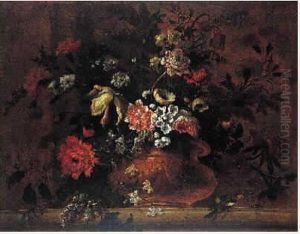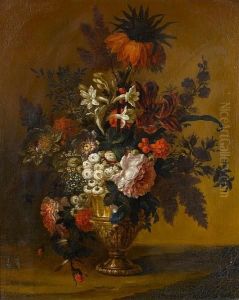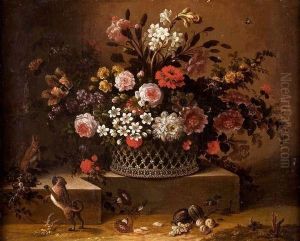Claude Huilliot Paintings
Claude Huilliot was a French painter and engraver, recognized for his contributions to the world of still life painting in the 18th century. Born in Paris in 1700, Huilliot's artistic journey began in the vibrant cultural milieu of the French capital, a hub for artists, intellectuals, and innovators during the Enlightenment period. Though detailed records of his early life and training are scarce, it is evident from his body of work that Huilliot developed a profound mastery over the depiction of objects, particularly in the genre of still life, which was gaining popularity at the time.
Huilliot's artistry was deeply influenced by the prevailing artistic trends in France as well as by the works of his contemporaries and predecessors. He was particularly known for his meticulous attention to detail, his ability to render textures and surfaces with remarkable realism, and his subtle use of light and shadow. His compositions often featured an array of objects, from the luxurious to the mundane, each carefully chosen and arranged to create a harmonious and visually captivating tableau. These still lifes not only showcased his technical skill but also reflected the tastes and interests of the period, including a fascination with exotic goods brought to Europe through expanding trade networks.
Despite the high quality of his work, Claude Huilliot did not achieve the same level of fame as some of his contemporaries. Nevertheless, he enjoyed the patronage of a select group of collectors and was respected among his peers. His works were primarily distributed among private collections, and as a result, they did not always receive widespread public recognition during his lifetime. However, in the years following his death in 1771, Huilliot's paintings have been increasingly appreciated for their contribution to the development of still life painting in France. Today, they are studied for their aesthetic beauty as well as their insights into the cultural and material history of the 18th century.
Throughout his career, Huilliot also engaged in engraving, a practice that allowed him to reproduce his own works as well as those of others, thereby extending his influence beyond his original paintings. This aspect of his work highlights the interconnectedness of the art world during his time, where the roles of painter, engraver, and collector often intersected. Claude Huilliot's legacy, though quieter than that of some of his contemporaries, remains significant for historians and collectors alike, offering a window into the subtlety and complexity of 18th-century French art.


